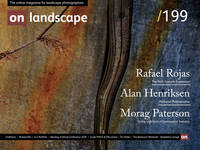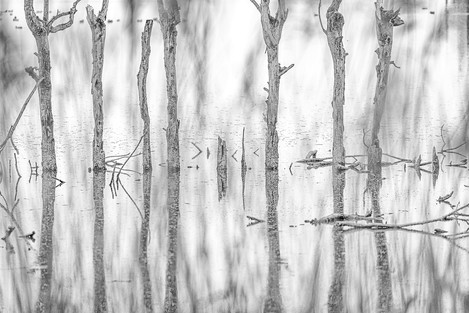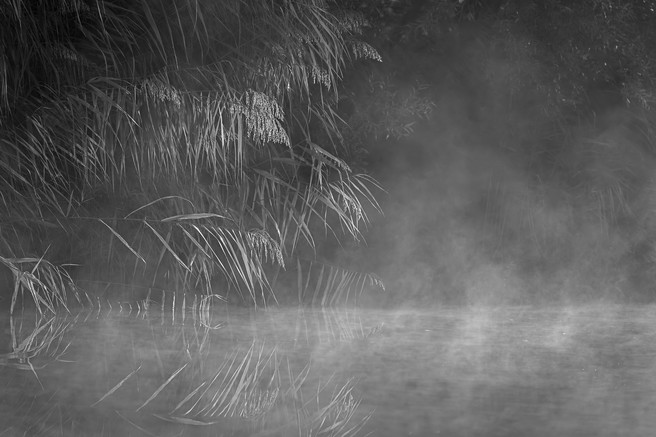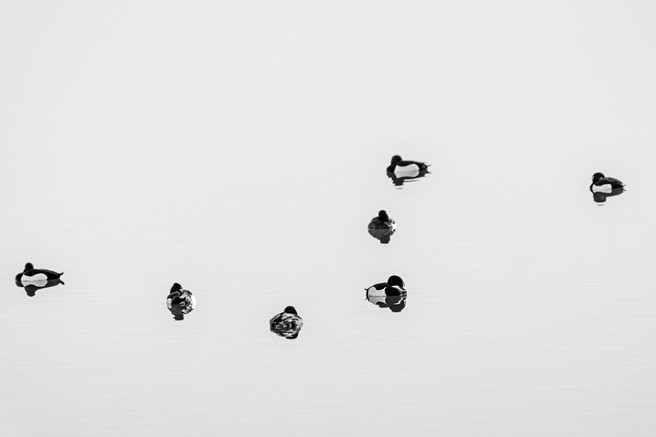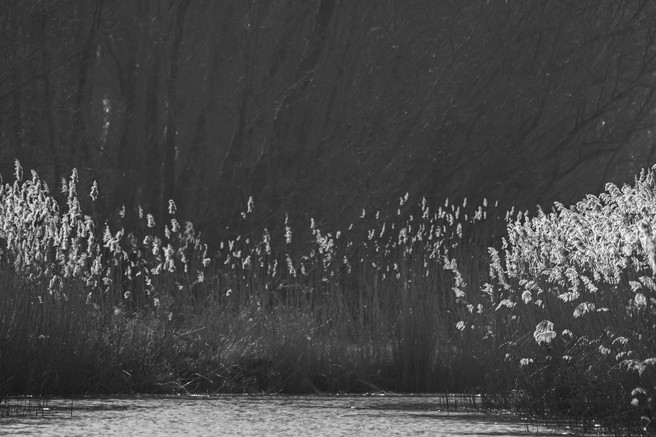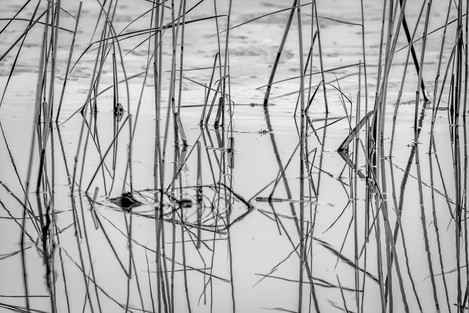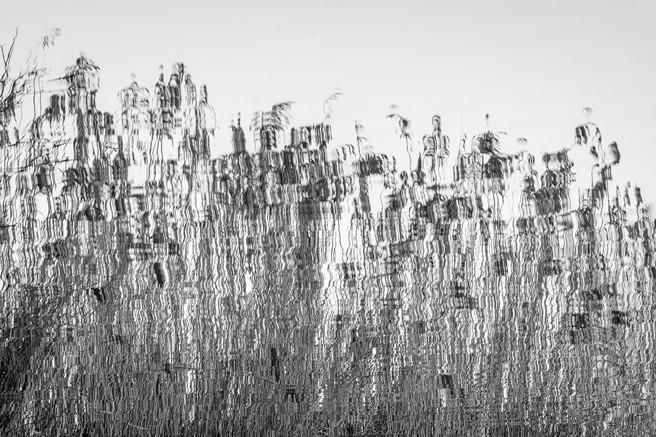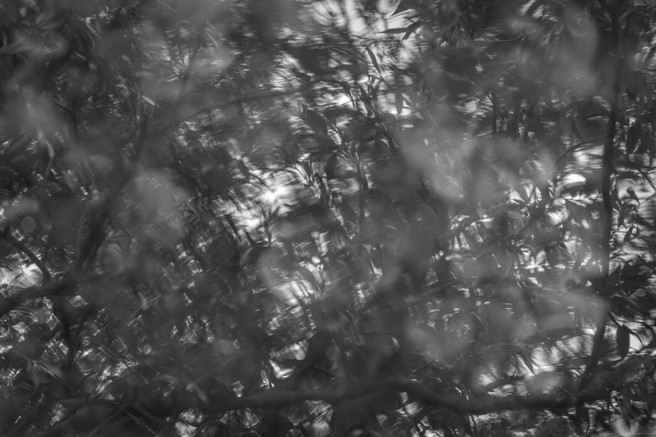Capturing the soul of a place

Madeleine Lenagh
Madeleine grew up in the 1950’s on the north-eastern coast of the United States. She was given her first camera when she was 18. But it wasn’t until after her retirement in The Netherlands that she plunged into her photography wholeheartedly.
Her approach to landscape photography is expressive and often abstract. She lets her moods and the conditions she encounters dictate her images.
As a nature lover, she’s committed to treating nature with respect and is ambassador for Nature First, the Alliance for Responsible Nature Photography.
This time, the water won, reclaiming all that humans had wrought. The contours of tree-lined farm lanes are still visible in the skeletons of submerged trees. When they finally topple or are felled by beavers, they will feed the encroachment of rustling reeds. Silence has descended, broken only by the soft whistling of tufted ducks, the croak of an egret, or the squawking of geese flying up to escape a marauding eagle. Roe deer soundlessly appear at the edge of an island and slip away again like ghosts. Light plays on the water, which ripples with movement caused by underwater life and tidal currents. This is a world of light and reflections, of mist and shadow.
In 2017 I embarked upon a photography project that would eventually take me almost three years to complete. My aim was to portray a hidden world that most visitors miss but, to me, forms the soul of the wetlands national park known as The Biesbosch.
When I moved to the densely populated Netherlands, after growing up in hilly New England, I found myself at a bit of a loss in Dutch nature. The strip of dunes protecting the land from the sea felt limited and over-crowded. The forests of the Veluwe are carefully tended and its Red Deer culled to keep them from destroying the habitat. It’s all so tame. But in time I grew to appreciate its quiet beauty.
It was this expanse of freshwater tidal wetlands, however, that really captured my imagination. The name ‘Biesbosch’ is derived from the Dutch word ‘bies,’ or bulrushes, a pioneer species that is eventually supplanted by reeds and various types of willows. This delta swamp, about 300 sq. kilometres in size, had been reclaimed for farmland and villages in the early Middle Ages. But civil wars diverted funding from the upkeep of the dykes, and, during a series of severe storms in the 15th century, they broke several times, flooding the area. Eventually, humans left the Biesbosch and it became a sunken world. In later centuries, some of the Biesbosch was once again reclaimed and farmed. Its tides were stemmed by the great barrier dams of the southwestern coast.
But recently the Netherlands adopted a policy to create overflow locations close to the great rivers, allowing sudden increases in water levels to divert and flood the land, thereby preventing more serious flooding. The Biesbosch became one of these designated overflow spots, which meant lowering dykes and moving farms. The Haringvliet Dam has been opened slightly to allow for tidal movement and the return of the great sturgeon. Gradually, the water is taking over again.
Something about this history triggers in my mind an association with what might happen in the future when climate change causes the seas to rise and reclaim large populated regions. I might mourn the loss of some of the beauty that we humans have created through the ages, but I would like to think that birds, animals, and plants would thrive, and that nature would reign again, undisturbed by humans.
Most visitors only see the populated face of the Biesbosch: water recreationists, a network of powerlines on huge pylons, herds of imported exotic grazers (Highland cattle, Konik horses, and even Water Buffaloes), and the remaining farms with their fields and livestock. The world of water, reeds, and their denizens is usually hidden from these visitors, and fortunately so. The presence of humans (even my presence) makes ripples in this world. Luckily the ripples are brief and eventually fade away. There are vast expanses of water and reeds, but also a maze of narrow creeks one could get lost in. The water in the hidden creeks is sometimes only 20-30 cm deep and so limpid that you can see everything below the surface.
Because I live very close to the Biesbosch, it has become my favourite photography haunt. I go out in all weather, at all times of day, and in all seasons. Ospreys and crested grebes, roe deer and beavers, morning mists, reflections in the water… there are always inspiring images to capture. Besides, simply being out there soothes my soul. Whether I’m on foot, in a boat, or just driving slowly with the window rolled down and the camera within grabbing distance, all my senses are open, and my mind is on nothing else but my surroundings. Although it’s an experience I prefer to savour alone, occasionally I’ll be with one or two other photographers, but only if they don’t talk too much.
When I started feeling the need to develop my artistic eye and photographic skills further, a photographer I’ve always admired, Theo Bosboom, suggested that focusing on a project would be a good way to achieve this. He offers a course, which basically consists of a year of mentorship, guiding the photographer through the various steps towards producing a consistent series of images. It was exactly what I needed, and I signed up for it, choosing the Biesbosch as my project focus. After getting off to a false start (I fell and broke my right shoulder late 2017), I resumed work on the project in the fall of 2018.
But the early work I’d done had made one thing very clear to me: my original concept – a portrait of the Biesbosch throughout the seasons – was far too encompassing. I had no idea how to choose my images, what to include and what to ignore. And, even more important, I wasn’t sure how this would help me grow as a photographic artist. How to get past the standard landscape and bird portraits and delve into my perception of the soul of the place?
Theo suggested that I refine my project definition by writing out what I consider to be the soul of the Biesbosch. That’s when I sat down and wrote the words I’ve included at the beginning of this article. This text has been my guideline throughout the work. My aim is not to show people what the Biesbosch looks like. Other photographers have done that quite well. Alfred Stieglitz once wrote, “My photographs are ever born of an inner need – an Experience of Spirit … I have a vision of life, and I try to find equivalents for it sometimes in the form of photographs.” My aim is to portray this silent, drowned world of reflections, mist, and shadows that mirror my inner vision of life.
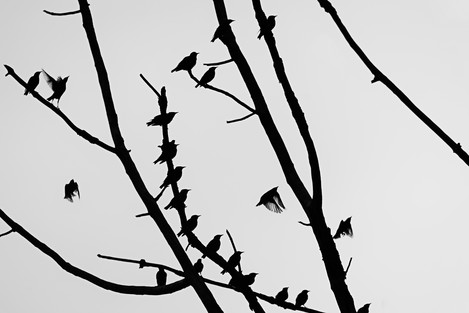
Spending more than a year photographing the same location was a surprisingly enriching experience. There were times, as I collected more and more images, that I wondered if I could possibly acquire new, fresh ones. Had I exhausted all possibilities? Somehow, this always resolved itself. I found myself going deeper and deeper, moving past the images I had built in my head and finding unexpected new ones. I had imposed a restriction upon myself: only black-and-white photos in 2:3 format. This challenged me not to rely on colour and cropping techniques. It meant focusing on the strength of composition, lines, and texture instead of the subject matter.
As I progressed, especially once I started thinking about the final selection of images, I kept a mental list of photos that I felt were missing. However, as most of you know, nature photography is serendipitous. And when you’re floating past a stunning scene in a boat, you only have one or two chances for a good capture. Some of the images I hoped for never materialised (or did, but the image quality didn’t meet my standards).
The final selection of photographs would prove to be as important and time-consuming a task as taking and processing the photos. The guiding principles involved more than simply choosing what I considered to be my best images. It meant creating a narrative; putting together a selection of photos that coaxed the viewer into the story and told it coherently, with enough variation to keep it interesting. It was far more difficult than I had expected.
Maybe because I never considered photography as a career, the primary motto guiding my choice of subjects has always been ‘Follow what you love.’ Since working on this project, I’ve added a second precept: ‘But stay out of your comfort zone.’ In the end, the images I was unsure about when taking the photo often turned out to be the best ones. Staying out of my comfort zone proved to be a valuable learning experience. I think, like many photographers, I tend to go for images that are easily readable and comfortable for the viewer: recognizable subject matter using standard rules of compositions. I started experimenting with abstract, impressionistic images, chaotic compositions, the sort of image people might respond to with “What is it?” My explorations started having an effect on my other photographic work. I started to understand why experienced photographers might go out for an entire day and come back with only one image that they’re happy with. This, more than anything else, has contributed to my original goal: honing my skills as a photographic artist.
When you compare this flat, watery expanse of reeds and willows to more iconic locations for landscape photography, the Biesbosch would seem a very dull place.
I’m very grateful to Theo Bosboom for guiding me through this process with patience, well-timed suggestions, and respect for my creative style. And what have I learned from the project? Obviously, I’ve learned to put together a consistent series of photographs that tells a tale. I’ve also learned to view my work critically and not accept images that fall short of my highest standards. But – and maybe this is the most important lesson of all – I have learned to look carefully and delve deep when I want to discover the soul of a location. The Biesbosch is a magical place, but you will only see the magic if you pay attention.
In the words of the poet Mary Oliver:
Instructions for living a life:
Pay attention.
Be astonished.
Tell about it

